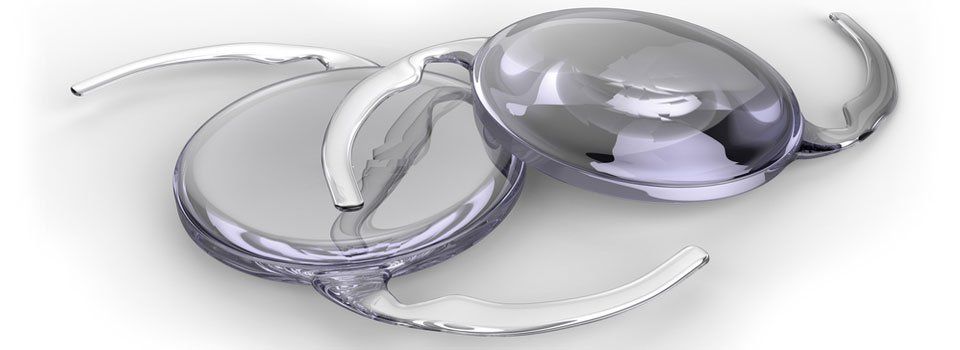INTRAOCULAR LENS IMPLANTS (IOLs)
Intraocular Lens Implants, or IOLs, are artificial lenses used to replace the eye’s natural lens during cataract surgery. IOLs have been around since the mid-60s, although the first one wasn’t approved by the FDA until 1981. Prior to that, the natural lens wasn’t replaced with an artificial version, so it was customary to wear very thick eyeglasses or special contact lenses after cataract surgery.
Until recently, weighing the benefits and risks of various IOLs fell solely on the cataract surgeon. The surgeons’ decisions were heavily based on surgical techniques (size of the incision, clear cornea, etc.), the physical design of the lenses (multi-piece vs one-piece, silicone vs acrylic, etc.), along with how a design might affected insertion, positioning and healing.
Today, new IOLs solve more vision problems than ever before, meaning cataract surgeons have even more to consider before deciding on an IOL for their patients. As such, cataract patients have now become much more involved in the decision making process.
If you or someone you know will be undergoing cataract surgery, it is important to consider your IOL option types below.
WE WOULD LOVE
TO SEE YOU
Contact Us
LENS IMPLANT TYPES
A. Standard Monofocal Lenses
Standard Monodical lenses are the most commonly used intraocular lens implants used at the time of cataract surgery. These standard lenses have been in use since 1949, and are normally going to be the only option that Medicare or a private insurer will cover.
They are spherical lenses that attempt to match a patient’s primary focal length, so they come in varying powers. This time-tested monovisual approach is still considered the standard when it comes to addressing long-distance vision.
With these monofocal lenses, vision is normally in focus at only one distance (near, intermediate or far). Alternatively, an IOL can be implanted in one eye to improve distance vision, while another is implanted in the other eye to improve near vision. This technique is known as monovision.
Advantages of monofocal lenses:
* The cost of standard monofocal lenses is fully covered by Medicare and private insurance companies.
* In cases where glasses or contacts are required after surgery, vision for driving at night or in low light is sometimes better than it is with multifocal IOLs.
Disadvantages of monofocal lenses:
* Those with IOLs for distance vision correction still require reading glasses to improve near vision.
* Those with IOLs for near vision correction still require glasses to improve distance vision.
* Some people do not adjust well to monovision as the brain has to process different information from each eye.
* Astigmatism may still cause blurred vision both near and far when glasses are not worn.
B. Multifocal & Accommodative Lenses
Multifocal IOLs and Accommodative lenses are designed to correct vision at near, intermediate and far distances. They contain several concentric rings of varying optical power, each of which bends incoming light into focus at different points simultaneously.
Accommodative lenses rely on the eye muscles to move the IOL backward and forward to change focus, and provides the best results when used in both eyes.
Advantages of Multifocal and Accommodative Lenses:
* Approximately 85% of people with multifocal IOLs do not need glasses for near or distance activities.
* Accommodative lenses normally offer very good distance (driving) and intermediate (computer) vision, but are not as good for near (reading) vision.
Disadvantages of Multifocal and Accommodative Lenses:
* Roughly 5-10% of multifocal implant patients experience some level of glare, halos or starbursts around lights at night. This is far less common with accommodative implants.
* Multifocal lenses are associated with some loss in contrast, typically as reduced near vision clarity in low light situations (like reading a menu in a dimly lit restaurant). This is not the case with accommodative implants.
* Non-Toric Multifocal and Accommodative lenses do nothing to correct astigmatism.
* Medicare and private insurers very rarely cover the costs of Multifocal and Accommodative lenses, or any of the associated costs exceeding that of a conventional IOL.
C. Toric Lenses for Astigmatism
Toric IOLs are designed to correct astigmatism at the time of cataract surgery. They are considered premium lenses, and will likely cost extra because “premium” options simply aren’t covered by most insurance plans. They are shaped to offset an imbalance created by an irregular shape in the cornea. Once implanted inside the eye, they stay in a fixed alignment to eliminate pre-existing astigmatism conditions.
There are several manufacturers of Toric IOLs available to correct various amounts of astigmatism. Your doctor will help you select the Toric IOL best suited to your eye condition.


